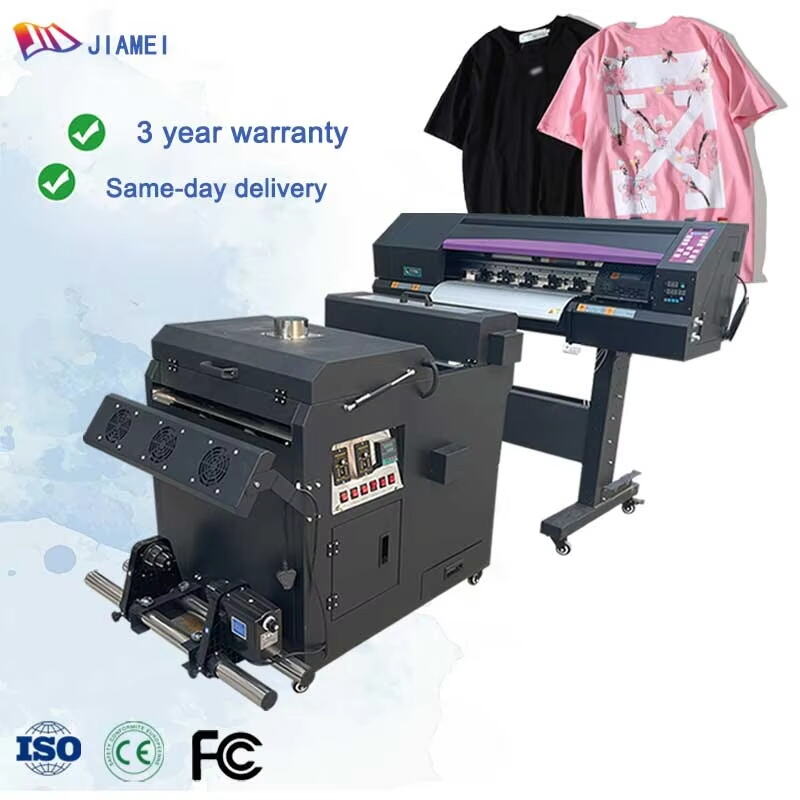Importance of Selecting the Right Digital Printer for Business Growth
Selecting the best digital printer for business is a strategic decision that can significantly enhance business visibility and efficiency. The right printer not only streamlines operations but also leads to improvements in productivity and cost savings. By aligning a digital printer with specific business needs, organizations can ensure smooth workflows and lower operational costs. A well-chosen printer thus becomes an asset, contributing to long-term business growth.
Moreover, digital printers are pivotal in conveying a business's brand identity through high-quality prints. Consistent and professional print outputs reinforce brand professionalism and trust among clients. When businesses select a printer that meets their specific quality requirements, it enhances their brand's image and credibility in the competitive market. Thus, choosing the right digital printer is not just about functionality but also about representing the company's ethos in every printed material.
Types of Digital Printers for Business Applications
Inkjet Printers: Versatility for Mixed Media
Inkjet printers are renowned for their versatility, especially suitable for printing on various media such as paper, plastic, and fabric. This versatility makes them ideal for businesses with diverse printing requirements, allowing for creative projects and custom outputs. They typically produce high-quality images, particularly in full color, which is advantageous for marketing materials aimed at capturing consumer attention. Notably, market research indicates that inkjet printer sales have grown by over 10% annually due to their adaptability.
Laser Printers: Speed for High-Volume Tasks
Laser printers are known for their impressive speed and efficiency, making them perfect for high-volume tasks without compromising on print quality. Utilizing toner, laser printers offer lower cost-per-page metrics, which is ideal for businesses that require frequent, substantial print outputs. Research shows that switching to laser technology can save businesses up to 40% in printing costs. Furthermore, laser printers provide crisp text and detailed monochrome prints, and they are highly effective for general document printing needs.
DTF/UV/Sublimation Printers: Specialty Applications
DTF (Direct-to-Film), UV, and sublimation printers are tailored for specialty applications, such as custom apparel, promotional items, and signage. These technology-driven printers are perfect for businesses that need unique printing solutions to cater to niche markets. By leveraging these specialty printers, businesses can diversify their product offerings, enhancing their ability to meet specific customer demands creatively and efficiently. This can lead to increased market reach and the potential for new revenue streams.
Key Factors to Consider When Choosing a Business Digital Printer
Assessing Print Volume Requirements
When choosing a business digital printer, it's crucial to assess your print volume requirements. Understanding the expected print volumes enables businesses to select printers compatible with their operational demands. To accurately evaluate this, businesses need to calculate their monthly print needs. This evaluation helps align the printer's specifications with actual operational demands, ensuring the business runs efficiently. By doing so, companies can avoid potential printer failures and ensure that they are making a cost-effective investment.
Evaluating Print Quality vs. Speed Tradeoffs
Decision-makers must consider the tradeoff between print quality and speed when selecting a digital printer. For many businesses, higher quality prints, such as those needed for marketing materials, may take longer to produce. Conversely, faster printers tend to compromise on resolution, which might affect output quality. Balancing these factors is crucial for cost efficiency and meeting business goals. Ultimately, the decision should align with the business's operational priorities, whether that be emphasizing speed for high-volume tasks or prioritizing quality for detailed image printing.
Material Compatibility for Industry-Specific Needs
Ensuring material compatibility is another critical factor when choosing a digital printer for business purposes. Different industries require varied materials for printing, such as paper, plastic, or fabric. Understanding these industry-specific needs is essential to ensuring that the selected printer can meet the operational requirements efficiently. For example, a company in the textile industry might prioritize printers adept with fabric, while a marketing firm might focus on color accuracy for paper and plastic media. Choosing the right printer guarantees that operations are smooth, versatile, and capable of handling the specific demands of their industry.
Maximizing ROI with the Right Digital Printer
Efficiency Improvements Through Automation
Implementing a digital printer with automation capabilities can significantly enhance operational efficiency, reducing manual tasks and errors. By automating processes, businesses can streamline their workflow and minimize human intervention, which often leads to mistakes and delays. Additionally, research shows that companies adopting automated printing solutions can improve productivity by up to 30%. This boost in efficiency not only maximizes ROI but also optimizes resources and enables staff to focus on more strategic tasks, ultimately driving business growth.
Reducing Waste with Precision Technology
Precision technology in digital printers is crucial for minimizing waste, ensuring that resources are used effectively. These printers offer targeted printing processes, reducing material consumption and saving costs. Waste reduction through precision technology supports sustainability initiatives, which are increasingly important in today's business landscape. Besides cost benefits, this approach aligns with eco-conscious practices—integral to modern corporate strategies—and contributes to building a sustainable future. Implementing a printer that leverages precision engineering is an essential step in driving both financial efficiency and environmental responsibility.
Common Pitfalls in Business Printer Selection
Overestimating Capacity Needs
One common mistake businesses make when selecting printers is overestimating their capacity needs. This often leads to excessive spending on high-capacity models that offer more than what is actually necessary. For instance, a company with moderate printing requirements might invest in an industrial-grade printer, incurring avoidable costs. To prevent such unnecessary expenditures, it is crucial to conduct a comprehensive analysis of printing needs. By understanding the realistic demands, businesses can make informed decisions that align with their operational requirements and budgets.
Underestimating Maintenance Requirements
Another significant pitfall in printer selection is underestimating the maintenance requirements. Many businesses overlook the continuous costs associated with printer upkeep, which can significantly impact the total cost of ownership over time. These costs include regular servicing, parts replacement, and technical support. Without a clear understanding of these maintenance needs, organizations may face unexpected financial strains that could have been anticipated with thorough planning. Awareness and budgeting for maintenance not only prevents surprise expenses but also ensures that printers operate efficiently throughout their lifespan.
Ignoring Future Scalability
Ignoring future scalability is a frequently encountered oversight in printer investments. Businesses that fail to consider their future growth potential may end up with equipment that quickly becomes obsolete. For example, a company experiencing rapid expansion might find that their current printer doesn't support increased usage or the variety of functions required as the business grows. Investing in scalable solutions, therefore, becomes imperative. Scalable printers accommodate growth without frequent and costly upgrades, allowing businesses to adapt and thrive in a rapidly changing environment.
Recap Tips for Selecting the Best Digital Printer for Your Business Goals
Selecting the most suitable digital printer for your business involves thoughtful consideration of your specific needs and a careful avoidance of common pitfalls that can lead to costly mistakes. Taking into account factors such as print volume and material compatibility ensures that you choose a printer that aligns with your demands. It is crucial to perform a detailed evaluation of your printing requirements to match the printer's capacity appropriately and avoid excessive spending on unnecessary features.
Additionally, considering the long-term return on investment is essential to make sure your printer acquisition supports your business's growth and does not become a financial burden. This includes analyzing the initial costs in relation to the expected output and efficiency improvements. By performing this assessment, you can optimize the benefits gained from your printing investments, ensuring they truly enhance your operations and support your future objectives. Selecting the right digital printer is not just about meeting immediate needs but also preparing for scalable growth as your business evolves.
Frequently Asked Questions
What type of digital printer is best for a versatile printing solution?
Inkjet printers are best for versatile printing solutions since they can handle a variety of media such as paper, plastic, and fabric, making them ideal for businesses with diverse printing needs.
How can I balance print quality and speed when choosing a digital printer?
When choosing a digital printer, consider your business priorities. If high-quality prints for marketing are a priority, opt for a printer that excels in resolution, even if it's slower. Conversely, if speed is crucial for high-volume tasks, a laser printer may be more suitable.
Why is it important to consider material compatibility in choosing a digital printer?
Material compatibility ensures that the printer can efficiently handle the specific materials your business requires, whether paper, plastic, or fabric, thus ensuring smooth operations and quality outputs.
How does automation in digital printers enhance ROI?
Automation enhances ROI by streamlining workflow, reducing manual errors, and increasing productivity. Automated processes optimize resources and free up staff for more strategic tasks, contributing to growth.
What are the common pitfalls to avoid when selecting a business digital printer?
Common pitfalls include overestimating capacity needs, underestimating maintenance requirements, and ignoring future scalability. Thorough analysis and planning can help businesses make informed, cost-effective decisions.
Table of Contents
- Importance of Selecting the Right Digital Printer for Business Growth
- Types of Digital Printers for Business Applications
- Key Factors to Consider When Choosing a Business Digital Printer
- Maximizing ROI with the Right Digital Printer
- Common Pitfalls in Business Printer Selection
- Recap Tips for Selecting the Best Digital Printer for Your Business Goals
-
Frequently Asked Questions
- What type of digital printer is best for a versatile printing solution?
- How can I balance print quality and speed when choosing a digital printer?
- Why is it important to consider material compatibility in choosing a digital printer?
- How does automation in digital printers enhance ROI?
- What are the common pitfalls to avoid when selecting a business digital printer?

